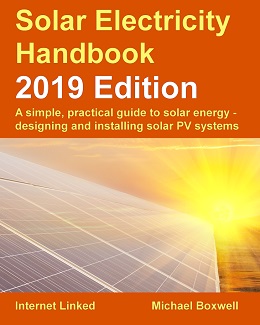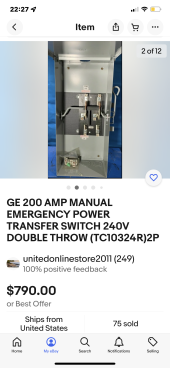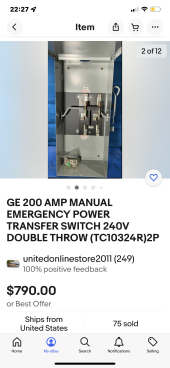You are using an out of date browser. It may not display this or other websites correctly.
You should upgrade or use an alternative browser.
You should upgrade or use an alternative browser.
I'm about ready to give up on solar
- Thread starter 1201
- Start date
Hedges
I See Electromagnetic Fields!
- Joined
- Mar 28, 2020
- Messages
- 20,784
I bought one on eBay for $40 ??
Different name, old-stock made by company they acquired, I think.
Oh, not that particular one ("General Duty", 240V)
Heavy Duty, 600V!
But how about, "Transfer Switch"?
(OK, the corrected link below to a transfer switch is much more interesting than a simple isolation switch. Those are hard to come by, especially 200A.)
Different name, old-stock made by company they acquired, I think.
Oh, not that particular one ("General Duty", 240V)
Heavy Duty, 600V!
But how about, "Transfer Switch"?
(OK, the corrected link below to a transfer switch is much more interesting than a simple isolation switch. Those are hard to come by, especially 200A.)
Last edited:
Nobodybusiness
Collecting the leftovers of the Great Sky Reactor.
Sorry at work.I bought one on eBay for $40 ??
Different name, old-stock made by company they acquired, I think.
Oh, not that particular one ("General Duty", 240V)
Heavy Duty, 600V!
But how about, "Transfer Switch"?
Selected wrong thing.
That was a fused Disconnect for Grid to inverter I never used..
Last edited:
Nobodybusiness
Collecting the leftovers of the Great Sky Reactor.
I have 2 of these.I bought one on eBay for $40 ??
Different name, old-stock made by company they acquired, I think.
Oh, not that particular one ("General Duty", 240V)
Heavy Duty, 600V!
But how about, "Transfer Switch"?
Attachments
Last edited:
Nobodybusiness
Collecting the leftovers of the Great Sky Reactor.
I have 2 of these..Are you by chance selling that transfer switch you didn't use? Thanks
Attachments
Last edited:
GXMnow
Solar Wizard
- Joined
- Jul 17, 2020
- Messages
- 2,716
I am still looking at the inverters that are coming out and what their software allows them to do, and I still do not see one that does what it should on it's own. What 400bird and I have done is make use of an external controller to tell a Schneider XW-Pro how much charge current to use, or how much export current to provide. The results are excellent, but it does require some programming ability. My setup is a lot smaller than what is proposed here, but you still have not shown us an energy audit. Here is an example of what my system can do with the XW-Pro hybrid inverter, fed from 4,800 watts of solar panels, and connected to a 36 KWH battery bank.
 This was my excellent solar production a few days ago.
This was my excellent solar production a few days ago.
 This is what the XW-Pro did with the battery bank.
This is what the XW-Pro did with the battery bank.
 And this is what So Cal Edison saw as my power usage for that day.
And this is what So Cal Edison saw as my power usage for that day.
Now this is with AC coupling from Enphase microinverters. It is actually much easier to make this work with DC coupled solar, except for the export part at 1 pm. Starting at midnight, the battery still had enough energy left to run all of the load in my house, and was in fact, exporting 20 to 30 watts until the sun came up. The stepping current is mostly the refrigerator and the furnace cycling through the night. The sharp down spikes are the microwave oven as I nuked up breakfast sausages, and then my GF made a Devour meal. As the sun comes up, my system has to tell the XW-Pro to charge. With a DC charge controller, that will just happen, and the XW-Pro will just keep running the loads. In my case, the power from the Enphase microinverters are running everything in the house from 9 am to 4 pm. The power beyond what the house need is being charged into the battery bank. But about 1 pm, the battery becomes completely full. So at that point, the Enphase solar inverter extra power does export to the grid. Because of the fairly coarse charging current steps, I have the system set to allow about 100 watts of export while there is extra power coming from the solar panels. But at 1 pm, the solar is putting out 2,400 watts more than the house is using. And with nothing to use it, it goes to the grid and I get NEM credit for it. Yes, it is at the low rate, but it is more than nothing. The utility company is not dumb, they set the high electric rate to begin at 4 pm, just as solar production falls below what the house needs. At that point, the XW-Pro starts to invert from the batteries to power the house. The current ramps up to after 5 pm as the solar is falling off. After that, the XW-Pro is running everything in the house from the batteries again, until midnight. And you can see the battery is back to about the same level as it was the midnight before. As long as I get enough sun, it does this day after day. But if it ever falls short, it just uses grid power, no big deal at all.
I will admit, I am cheating a little on those charts above. It barely shows in the battery voltage, but I do now also have 1,000 watts of DC coupled panels pushing a little more power into the battery bank. That system provides a power curve very similar to the Enphase solar, but at 1/5th of the power, and it goes directly to the battery. On a few days where the XW stopped early, you can see the battery voltage go up 0.2 to 0.2 volts while the XW is reporting no current.
The XW-Pro is not perfect, and the built in software has some limitation, especially with this AC coupled setup. Here is the same battery summary graph from back in 2020 before I had my PLC controlling it.

I had to manually tell it to start charging, it charged at fixed current until the battery was full, then it exported fixed power until the battery hit my low state limit. The ramp in the current was actually a surprise, and a good thing. The Enphase solar microinverters were still making some power, so the XW-Pro only added enough power to them to reach the export current that I asked for. As the solar power fell off, the current from the battery increased. With DC charging, you don't have the problem I had with manual charging. And by adding the Watt-Node meter to the Schneider system, it can export to the main panel with zero export control, very similar to what I am doing now.
Why did I post this huge long write up?
If you manage the solar power well with a battery bank, you can use your solar power all day. the lousy (or even no) credit for exported power becomes a non issue. Under my current NEM 2.0 plan, I get just about 50% credit for noon time power when I use evening peak rate power. But with this setup, I get no credit, but then buy no peak rate power either. So that makes the extra solar power worth twice as much to me. The day up above, I did export 5 KWHs to the grid. That happens from time to time, and it does add up. Then when I do have a cloudy day and I have to use some grid power, it has been able to cover it for a few months. I finally used up my credits at the end of Dec/early Jan when we had two weeks of cloudy rainy weather. So my bill cost me $27 after 3 months of zeros.
What you really need to do is look at your electric bills for a full year and see what your true KWH usage has been. And then also look at the hourly data if you can get it from your utility to see your curve for the day. Then you can get an idea if it is feasible to cover it like this. Also look up the solar insolation for your location. I use this web site for a reasonable estimate.

 www.solarelectricityhandbook.com
Click on "Online Calculators", then at the bottom left of the page "Solar Irradiance Tables".
www.solarelectricityhandbook.com
Click on "Online Calculators", then at the bottom left of the page "Solar Irradiance Tables".
Using my data, it says I should average 3.84 sun hours in January. I had a few days exceed 4 sun hours. With 4,800 watts of solar panels, 4 sun hours is 4 x 4,800 = 19,200 watt hours. I have topped 20 at the end of Jan. Feb says average 4.33, I am not up there yet, but should be by mid month. Come summer when my A/C has to run, I need over 30 KWHs a day, but I don't quite make it. So I did have a $150 summer electric bill. They used to top $350 before solar.
 This was my excellent solar production a few days ago.
This was my excellent solar production a few days ago. This is what the XW-Pro did with the battery bank.
This is what the XW-Pro did with the battery bank. And this is what So Cal Edison saw as my power usage for that day.
And this is what So Cal Edison saw as my power usage for that day.Now this is with AC coupling from Enphase microinverters. It is actually much easier to make this work with DC coupled solar, except for the export part at 1 pm. Starting at midnight, the battery still had enough energy left to run all of the load in my house, and was in fact, exporting 20 to 30 watts until the sun came up. The stepping current is mostly the refrigerator and the furnace cycling through the night. The sharp down spikes are the microwave oven as I nuked up breakfast sausages, and then my GF made a Devour meal. As the sun comes up, my system has to tell the XW-Pro to charge. With a DC charge controller, that will just happen, and the XW-Pro will just keep running the loads. In my case, the power from the Enphase microinverters are running everything in the house from 9 am to 4 pm. The power beyond what the house need is being charged into the battery bank. But about 1 pm, the battery becomes completely full. So at that point, the Enphase solar inverter extra power does export to the grid. Because of the fairly coarse charging current steps, I have the system set to allow about 100 watts of export while there is extra power coming from the solar panels. But at 1 pm, the solar is putting out 2,400 watts more than the house is using. And with nothing to use it, it goes to the grid and I get NEM credit for it. Yes, it is at the low rate, but it is more than nothing. The utility company is not dumb, they set the high electric rate to begin at 4 pm, just as solar production falls below what the house needs. At that point, the XW-Pro starts to invert from the batteries to power the house. The current ramps up to after 5 pm as the solar is falling off. After that, the XW-Pro is running everything in the house from the batteries again, until midnight. And you can see the battery is back to about the same level as it was the midnight before. As long as I get enough sun, it does this day after day. But if it ever falls short, it just uses grid power, no big deal at all.
I will admit, I am cheating a little on those charts above. It barely shows in the battery voltage, but I do now also have 1,000 watts of DC coupled panels pushing a little more power into the battery bank. That system provides a power curve very similar to the Enphase solar, but at 1/5th of the power, and it goes directly to the battery. On a few days where the XW stopped early, you can see the battery voltage go up 0.2 to 0.2 volts while the XW is reporting no current.
The XW-Pro is not perfect, and the built in software has some limitation, especially with this AC coupled setup. Here is the same battery summary graph from back in 2020 before I had my PLC controlling it.

I had to manually tell it to start charging, it charged at fixed current until the battery was full, then it exported fixed power until the battery hit my low state limit. The ramp in the current was actually a surprise, and a good thing. The Enphase solar microinverters were still making some power, so the XW-Pro only added enough power to them to reach the export current that I asked for. As the solar power fell off, the current from the battery increased. With DC charging, you don't have the problem I had with manual charging. And by adding the Watt-Node meter to the Schneider system, it can export to the main panel with zero export control, very similar to what I am doing now.
Why did I post this huge long write up?
If you manage the solar power well with a battery bank, you can use your solar power all day. the lousy (or even no) credit for exported power becomes a non issue. Under my current NEM 2.0 plan, I get just about 50% credit for noon time power when I use evening peak rate power. But with this setup, I get no credit, but then buy no peak rate power either. So that makes the extra solar power worth twice as much to me. The day up above, I did export 5 KWHs to the grid. That happens from time to time, and it does add up. Then when I do have a cloudy day and I have to use some grid power, it has been able to cover it for a few months. I finally used up my credits at the end of Dec/early Jan when we had two weeks of cloudy rainy weather. So my bill cost me $27 after 3 months of zeros.
What you really need to do is look at your electric bills for a full year and see what your true KWH usage has been. And then also look at the hourly data if you can get it from your utility to see your curve for the day. Then you can get an idea if it is feasible to cover it like this. Also look up the solar insolation for your location. I use this web site for a reasonable estimate.

The Solar Electricity Handbook - 2019 Edition
The Solar Electricity handbook - 2019 Edition - is a simple, practical book to using electric solar panels and designing and installing photovoltaic solar PV systems.
Using my data, it says I should average 3.84 sun hours in January. I had a few days exceed 4 sun hours. With 4,800 watts of solar panels, 4 sun hours is 4 x 4,800 = 19,200 watt hours. I have topped 20 at the end of Jan. Feb says average 4.33, I am not up there yet, but should be by mid month. Come summer when my A/C has to run, I need over 30 KWHs a day, but I don't quite make it. So I did have a $150 summer electric bill. They used to top $350 before solar.
Similar threads
- Replies
- 4
- Views
- 241
- Replies
- 5
- Views
- 166
- Replies
- 2
- Views
- 349
- Replies
- 5
- Views
- 212




